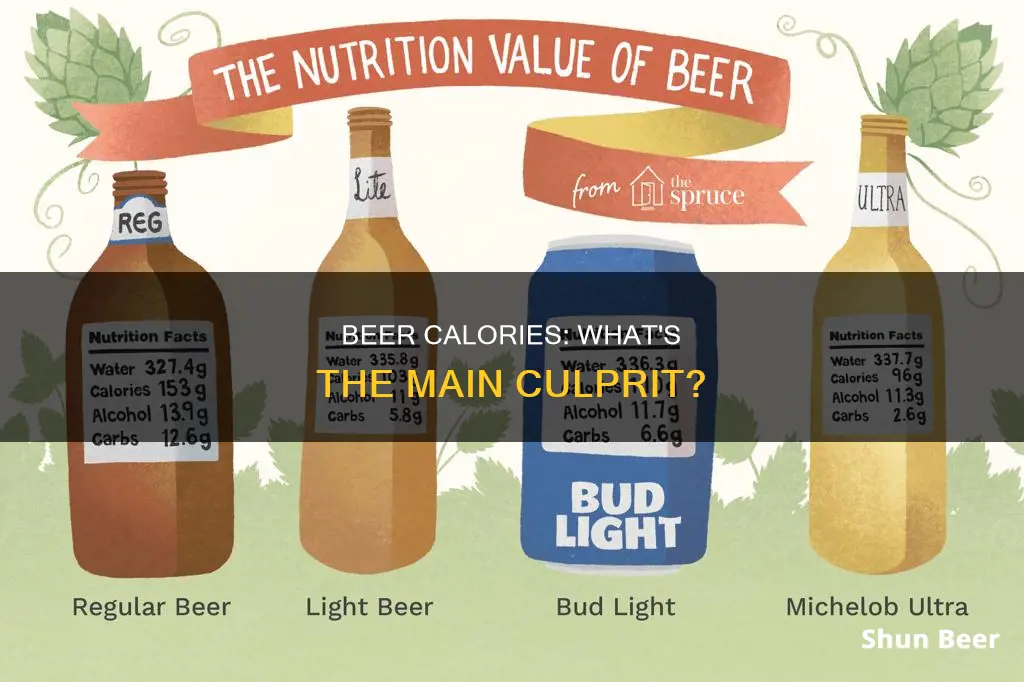
Beer is a popular drink worldwide, but it's also high in calories. The calories in beer come from two main sources: alcohol and carbohydrates. Alcohol contributes about 60% of the calories in beer, while the remaining 40% come from carbs. Beer is made by fermenting cereals, which produces alcohol, a highly calorific substance. The type of beer and its alcohol content play a significant role in determining the number of calories it contains. Lagers, for example, tend to have fewer carbs and calories than ales, which in turn have fewer than stouts. However, this is not always the case, as some lagers may have as many calories as dark beers. Understanding the calorie content of beer and making informed choices is essential for those watching their weight or aiming for a healthier lifestyle.
What You'll Learn

Alcohol content
Alcohol is a significant contributor to the calorie content of beer. According to the Homebrewer's Association, about 60% of the calories in beer come from alcohol, with the remaining 40% derived from carbohydrates. The calorie content of beer is influenced primarily by its alcohol concentration, with higher-alcohol beers generally containing more calories than their lower-alcohol counterparts.
The high calorific value of alcohol is due to the fact that a gram of alcohol contains seven calories, which is comparable to the calorie content of a gram of pure fat. This means that the more alcohol a beer contains, the higher its calorie count is likely to be.
The alcohol content of a beer is typically indicated by its alcohol by volume (ABV) percentage. A higher ABV indicates a higher alcohol content and, consequently, a higher calorie count. For example, a regular 5% ABV beer, such as Budweiser, contains approximately 150 calories. In contrast, very low-alcohol beers, with an ABV of 2% to 3%, start at around 60 calories for a 12-ounce serving.
The relationship between alcohol content and calories can be further illustrated by comparing different types of beers. For instance, IPAs, double IPAs, and Belgian-style Trippels, which have a higher alcohol content (ranging from 7% to 11% ABV), contain significantly more calories, with a typical count of 200 to 300 per serving. On the other hand, a lower-alcohol "session" IPA, with an ABV of around 4%, would contain approximately 140 calories.
Additionally, it is worth noting that non-alcoholic beers, which have an ABV of less than 0.5%, contain far fewer calories. As they lack the alcohol that contributes a significant proportion of calories, these beers can be a healthier alternative for those watching their calorie intake.
Beer vs Wine: Which Drink Packs More Calories?
You may want to see also

Carbohydrates
The carbohydrates in beer come from the grains used in the brewing process. These grains provide the natural sugars that yeast ferments into alcohol. The type of grains used can vary, but commonly include malted barley, which is fermented to produce alcohol. The residual carbohydrates that are not fully fermented during the brewing process contribute to the total calorie count of the beer.
Different types of beer contain different quantities of carbohydrates. For example, lagers tend to contain fewer carbs than ales, which in turn have fewer carbs than stouts. However, it's important to note that this is not always the case, as some lagers may contain as many carbohydrates as a dark beer.
Light beers typically have fewer carbohydrates and more water, resulting in fewer overall calories. These beers are designed to have a lower calorie count while still retaining the taste and mouthfeel of traditional beer. However, some people prefer the flavour and mouthfeel of beers with more carbohydrates.
When trying to reduce calorie intake, it is recommended to choose low-carb beers or light beers that have fewer carbohydrates and, consequently, fewer overall calories. Additionally, non-alcoholic beers tend to have fewer calories since they have little to no alcohol content. By reducing alcohol and carbohydrate content, brewers can create lower-calorie options for health-conscious consumers.
Kona Big Wave Beer: Calorie Count and Nutrition Facts
You may want to see also

Ethanol
The calories in beer come from carbohydrates and alcohol, with about 60% from alcohol and 40% from carbohydrates. Beer with a higher alcohol content will generally have more calories. A 12-ounce beer that is 4% ABV, for example, has about 150 calories, including 13 grams of carbs and 14 grams of alcohol.
Canadian Beer Calories: How Many in a Glass?
You may want to see also

Residual carbs
Beer is made from fermented grain, and the calories in beer are mainly made up of carbs and alcohol. The longer chains of carbs that are unable to be broken down by yeast during fermentation will remain in the finished beer as residual carbohydrates, contributing to the overall calorie count. It is said that, in general, about 60% of the calories in beer come from alcohol, and the remaining 40% come from residual carbohydrates.
Residual carbohydrates are the longer chains of carbohydrates that remain in the beer after fermentation because they cannot be broken down by the yeast. The simple carbohydrates are broken down, but the residual carbs linger and contribute to the overall calorie count.
The amount of residual carbohydrates in a beer can be calculated using the original and final gravities of the beer. The following formulae are used to determine the number of calories in a 12-ounce serving of beer:
Calories from alcohol = 1881.22 * Final_Gravity * (Original_Gravity – Final_Gravity) / (1.775 – Original_Gravity)
Calories from residual carbohydrates = 3550 * Final_Gravity * ((0.1808 * Original_Gravity) + (0.8192 * Final_Gravity) – 1.0004)
The sum of these two values will give you the total number of calories in the beer, with the first figure representing the calories from alcohol and the second, the calories from residual carbohydrates.
For example, if you have a pale ale with an original gravity of 1.054 and a final gravity of 1.010, the total calories would be about 179, with 116 calories from alcohol and 63 calories from residual carbohydrates.
Calorie Count of Shock Top Beer: Nutritional Facts
You may want to see also

Type of beer
The type of beer does affect its calorie content. The main sources of calories in beer are alcohol and carbohydrates. Alcohol contains about seven calories per gram, and beers with higher alcohol content will generally have more calories. For example, a 12-ounce beer with 5% ABV will have around 150 calories, while a beer with 8% ABV will have about 200 calories.
However, alcohol content is not the only factor that determines a beer's calorie content. Other factors include residual sugars, the type and amount of malt used, and the brewing process.
Residual sugars are the sugars that remain in the beer after fermentation. Beers with more residual sugars will have a higher calorie content, even if their alcohol content is the same as a beer with fewer residual sugars. This is because each gram of sugar contains about four calories.
The type and amount of malt used can also impact calorie content. Darker malts tend to have a higher calorie content than lighter malts as they contain more unfermentable sugars and other flavour compounds. Beers brewed with a higher percentage of malt will also have more calories, as more residual sugars will be left in the beer after fermentation.
Some beer styles, such as light beer or session IPAs, are designed to be lower in calories and carbohydrates, regardless of their alcohol content. These beers are often brewed with a lower percentage of malt and fewer residual sugars, resulting in fewer overall calories.
Light beers typically have around 100 calories per 12-ounce serving, while pilsners usually have 120-150 calories, wheat beers 120-180 calories, and session IPAs 120-180 calories per 12-ounce serving.
In general, beers that are lower in alcohol content and carbohydrates tend to be lower in calories. However, there can be exceptions, and it's worth noting that the specific ingredients and brewing processes can also impact a beer's calorie content.
Calorie Count in Kwak Beer: Nutritional Facts
You may want to see also
Frequently asked questions
The calories in beer come from alcohol and, to a lesser extent, carbohydrates. According to the Homebrewer's Association, about 60% of beer calories come from alcohol and the rest from carbs.
Light beers typically have fewer calories than regular beers due to their lower alcohol content. A 12-ounce serving of light beer ranges from 50 to 100 calories, while a regular 5% alcohol beer has around 150 calories.
To reduce your calorie intake, you can opt for lower-alcohol beers, choose non-alcoholic or low-calorie options, or simply drink less beer. Drinking a glass of water between alcoholic beverages and watching your portion sizes can also help.







